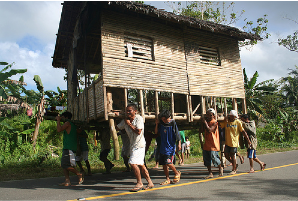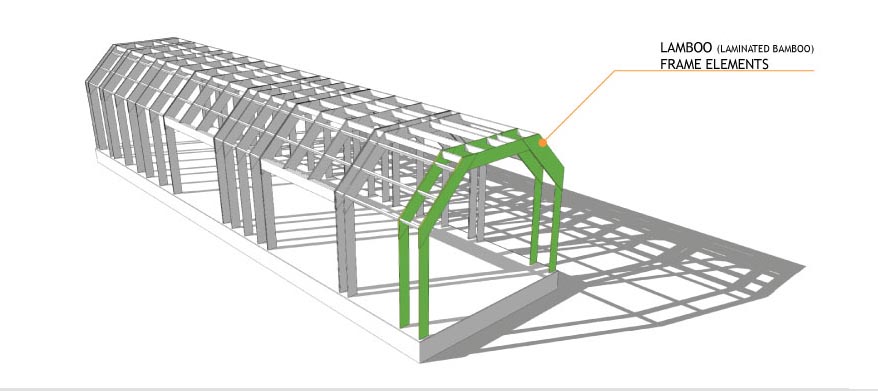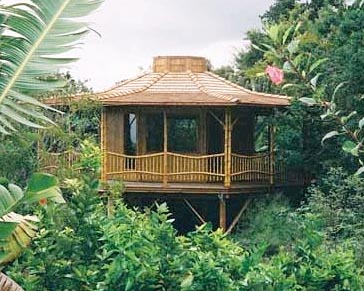Taiwanese experts opened a school in Marmelade, (Beauche) Haiti.
Rene Preval, Haiti’s president was born in Marmelade and was instrumental in starting a bamboo (artelier) school there.
The Taiwanese experts taught students to make bamboo furniture and three prototype houses.
The bamboo processing equipment was donated by Taiwan. The Taiwanese experts also encouraged farmers of that region to plant the bamboo as they are now doing in the Domincan Republic. The bamboo prevented erosion in the Marmelade region where the farmers planted it.
Instead of making walls and roof with cement (panels), if you start a bamboo factory in Haiti you will be able to hire women and men to make bamboo panels.
Haitian workers can daub cement plaster onto the bamboo- panels of lattice-work after the bamboo-wall-framework has been installed.
The bamboo in the walls allows strength and flex of the home walls. The roof could be of corrugated metal.
The strength and flexibility of bamboo-framed houses have been proven in previous earthquakes as in Costa Rica. Bamboo-framed houses also stand up to hurricanes well.
Jules Janssen of Eindhoven Technische Universiteit and Pablo van der Lugt of Technische Universiteit, Delft have done much hands-on research into developing building codes for bamboo.
The title of van der Lugt’s book is “Design Interventions for Stimulating Bamboo Commercialization – Dutch Design meets Bamboo as a Replica Model.”
Bamboo meets USA building codes. Architects and designers are building beautiful large bamboo buildings in Hawaii. Bamboo is becoming the rich man’s wood.
Haitians who no longer care to live in the houses which were built in the past can see in a bamboo-framed home that the roof and walls aren’t going to kill them and cause them to have limbs amputated.
On May 13, 2010 Taiwanese officials signed an agreement with the government of the Dominican Republic to start such a factory and school-workshop there.
–
Would you please be kind enough to read the attached INBAR construction PDF in the link above.
I am a teacher, former health department and agricultural inspector. I read four languages including dutch.
I will be going to teach in Haiti about July 15, 2010
Thank you very much.
Philip Wagner BS in Education



Hello- this is not what I have come to expect from you Mr. Collins.
This is a very interesting idea.
Bamboo would grow very well here, and could also be used as a block to protect food crops from the coastal winds. Food crops and Bamboo could be planted together in areas that have nothing holding the hillsides together.
Hello,I would like to make note that there is an error in the article above.
There are no bamboo homes built by Jeffree Trudeau in Haiti. INBAR also has not built any bamboo homes in Haiti.
Jeffree Trudeau is Special Project Director for World Bamboo Organization and we have been working with other companies and NGO’s to promote the use of bamboo by developing long term plantation proposals and to raise funding support for the building of as many bamboo homes as possible for long term shelter relief.
If you have any critique, please address it to the author of the material submitted.
His E-MAIL address is philip5147@gmail.com
Readers shouldn’t be surprised at the inclusion of a bamboo house project.
We have personally planted a lot of bamboo plants obtained from the Taiwanese embassy here. They started out at about 5 feet and are now over 50 feet high…in a couple of years.
They make great wind-breaks and the large bamboo plants provide good construction material Their root systems tied the soil together and fight erosion.
President Preval has a big bamboo plantation in Marmelade. The nation would be better off if he had stuck with agriculture.
Collins
Ten boys could also carry a house of this size down the street built of SIM panels. A single four foot by eight foot SIM (Structural Inuslated Metal)panel weighs only 45 pounds. See http://www.shelterusnow.com
Love these houses too. Except for fire, insects and rot, they look sustainable. Great work on this Blog. Bravo.
Hello- this is not what I have come to expect from you Mr. Collins.
This is a very interesting idea.
Bamboo would grow very well here, and could also be used as a block to protect food crops from the coastal winds. Food crops and Bamboo could be planted together in areas that have nothing holding the hillsides together.